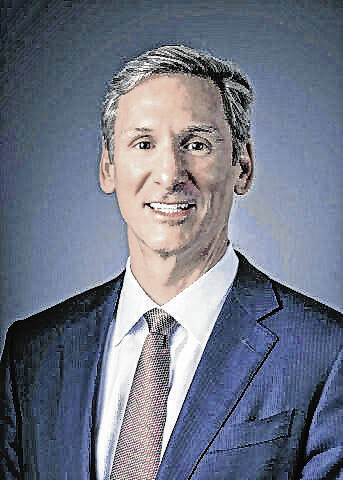Cummins Inc. has outlined its long-term growth strategy as concern mounts about catastrophic climate change and the world economy appears poised to start shifting away from the fossil fuels traditionally used in the company’s engines.
Company executives described the energy transition as a “growth opportunity” for Columbus’ largest employer.
The Columbus-based company took its message directly to investors and analysts Wednesday during its annual analyst day event, which was held virtually due to the pandemic. The event came one day after Cummins announced plans to acquire automotive components maker Meritor Inc. for $3.7 billion.
The strategy, which was outlined by several of the company’s leaders, including Cummins Chairman and CEO Tom Linebarger, largely involves investing in and producing technology that company officials believe will play a key role in the path to zero emissions, including a broad range of clean diesel and other lower-emission technologies.
“Cummins has never been in a better place,” Linebarger said during the event, speaking from the company’s downtown Indianapolis office.
But “our industry has to change,” Linebarger said. “We are a big user of fossil fuels. We are a big generator of carbon in our industry. The commercial and industrial market has to decarbonize. The good news for Cummins is that decarbonization is a growth opportunity for us.”
Much of the focus at Wednesday’s event was on Cummins’ New Power business segment, which includes the company’s growing electrified power and hydrogen portfolios and represents much of its efforts to invest in technologies that seek to curb greenhouse gas emissions.
During the event, Cummins unveiled an annual revenue target for the New Power segment of $6 billion to $13 billion by the end of the decade. By comparison, that segment pulled in $114 million in revenue last year.
The company’s New Power business is headquartered in Columbus.
However, the transition to zero emissions doesn’t mean that the internal combustion engine is going away any time soon, Linebarger said.
“No matter whose transition curve you use — the most aggressive, the least aggressive — you still see significant internal combustion engine across all of our markets globally for a significant period of time,” Linebarger said. “Some (markets) will transition fast, some will transition slowly.”
But Cummins is preparing for a range of scenarios “since nobody really knows exactly how the transition is going to go,” Linebarger said.
The event came as the diesel industry finds itself at a crossroads of sorts now, as alternative fuel technology grows in viability and concerns about catastrophic climate change continue to reshape how companies and policy makers think about energy consumption.
Diesel fuel is refined from crude oil and is used to fuel compression-ignition engines named after their inventor, Rudolf Diesel, according to the U.S. Department of Energy.
Most freight and delivery trucks, buses, farm and construction vehicles, as well as some cars and pick-up trucks, use diesel engines, the U.S. Energy Information Administration says.
But that is expected to change in the coming decades, with the industry accelerating toward number of more environmentally-friendly fuel types and power sources, including, among others, battery electric, hydrogen and natural gas engines.
How the transition plays out and could have major implications for a city like Columbus, whose economy is heavily rooted in automotive manufacturing.
Besides Cummins, which employs about 8,000 people in the area, Faurecia makes exhaust systems and components, PMG Indiana produces transmission components and shock absorbers and Tobar Inc. makes oil seals and other products.
Additionally, other companies have set up shop in Bartholomew County to supply Cummins with parts.
Cummins recently unveiled plans to start selling unified engine platforms, described as “fuel agnostic,” that can accommodate a range of lower-emission fuels in what the company claims are the first of its type on the market.
Earlier this month, Cummins announced plans to acquire engine brake manufacturer Jacobs Vehicle Systems for $325 million. The company is a supplier of braking systems primarily used in heavy-duty truck engines, including the “Jake Brake” diesel engine brake, which was invented by Cummins founder Clessie Cummins.
Last year, Cummins said it had started testing a hydrogen-powered internal combustion engine.
But the shift away from fossil fuels has several challenges, including building out infrastructure, which Cummins officials have often described as a “chicken-and-egg problem.”
“The company is going through a period of transformation,” Cummins President and Chief Operating Officer Jennifer Rumsey told The Republic following the event. “We definitely want to maintain some of the legacy and things that make Cummins who we are and have been a core part of the company for the first 100 years. …And we also need to think about how we reposition the company for the future as decarbonization occurs.”
“Columbus is playing a critical role for us (in the transformation),” Rumsey said in the interview.





